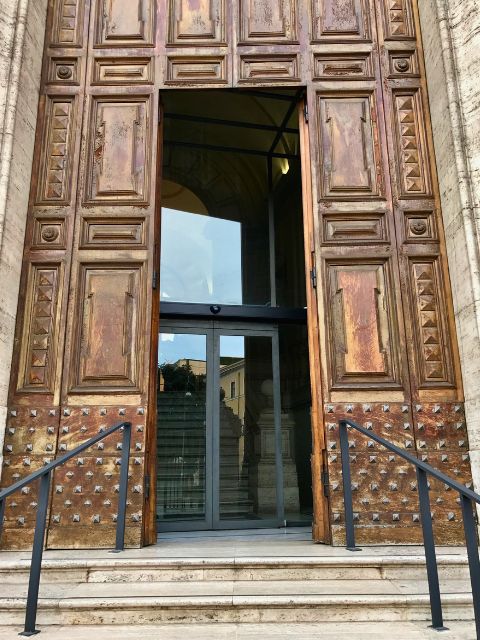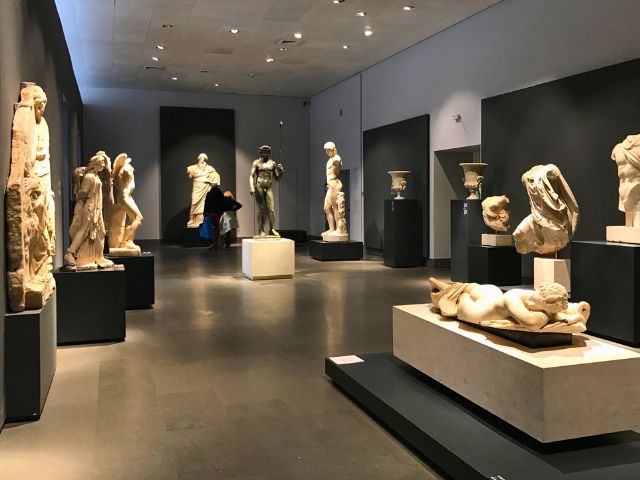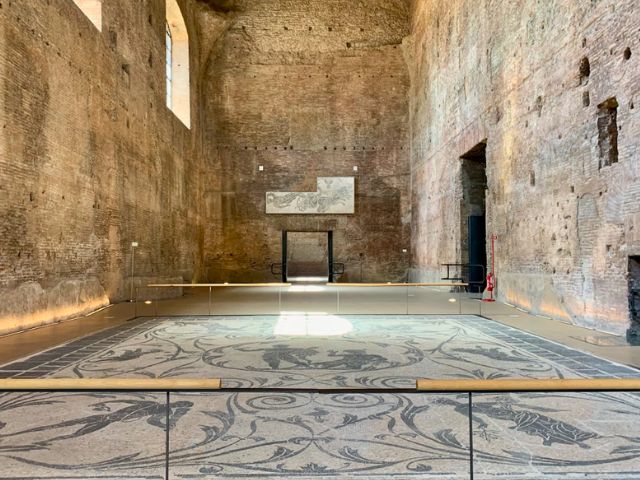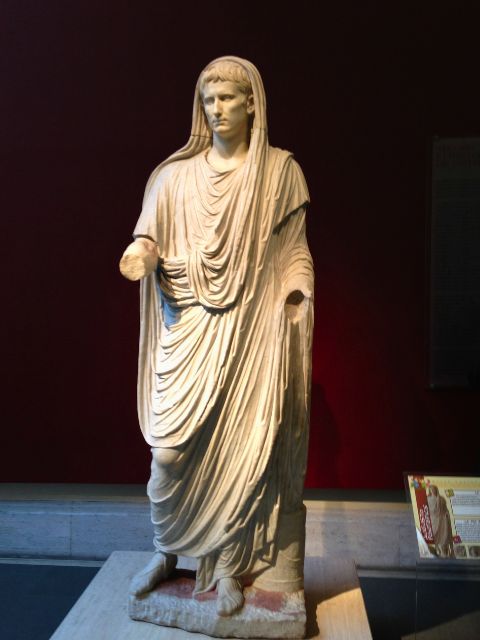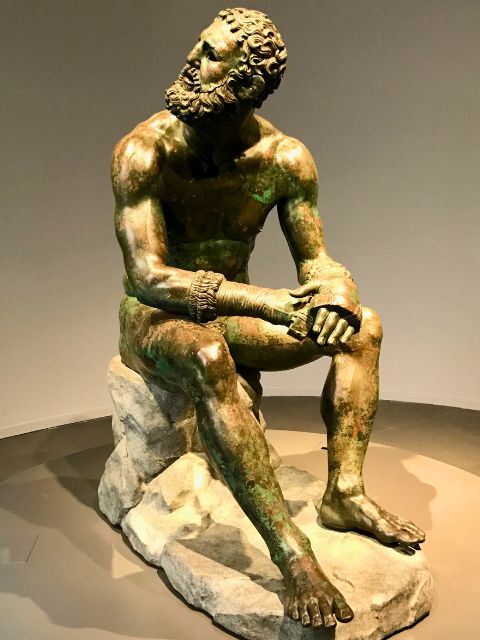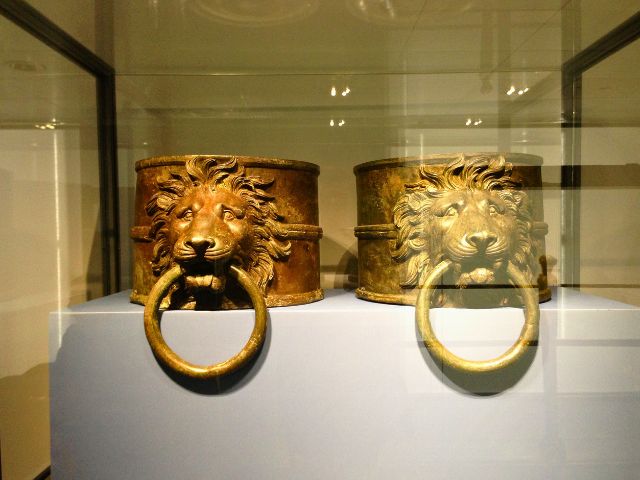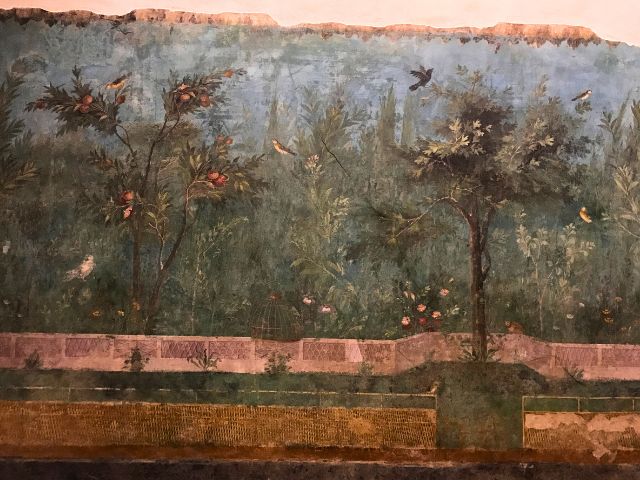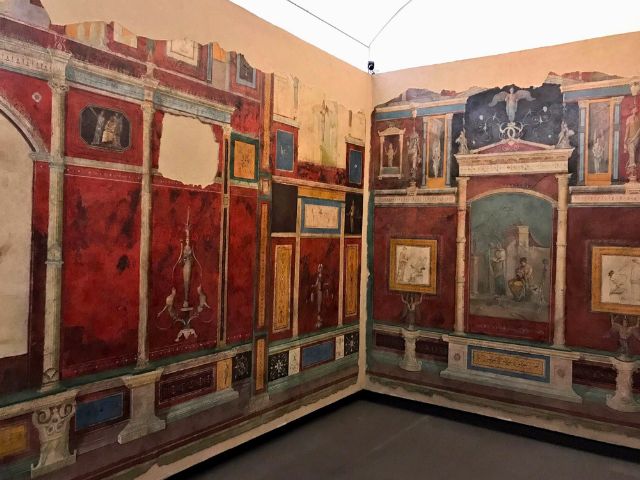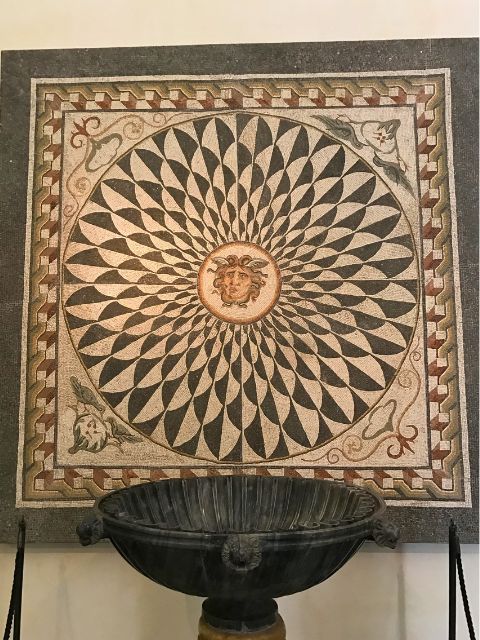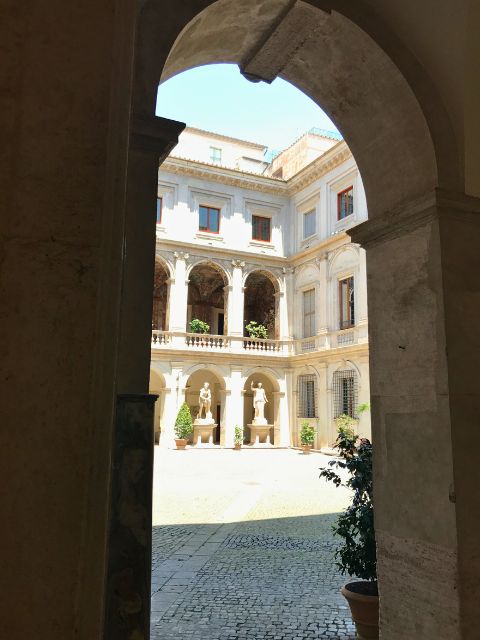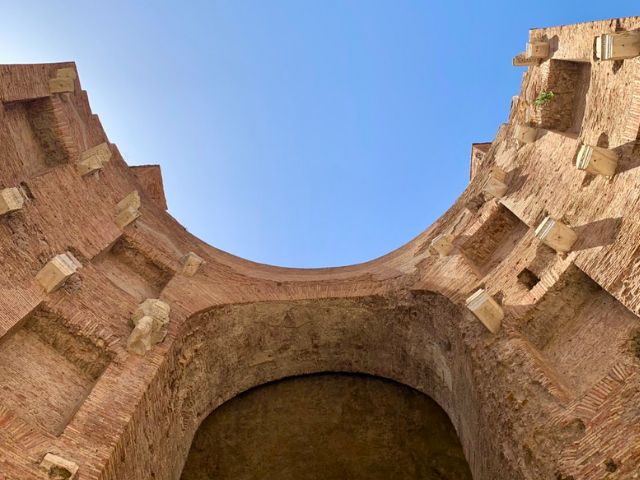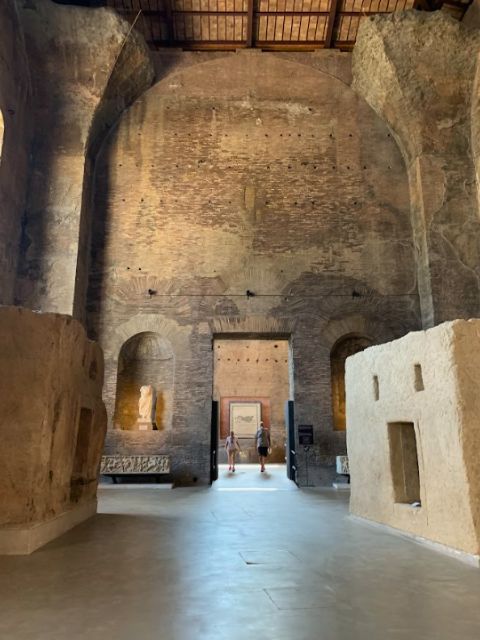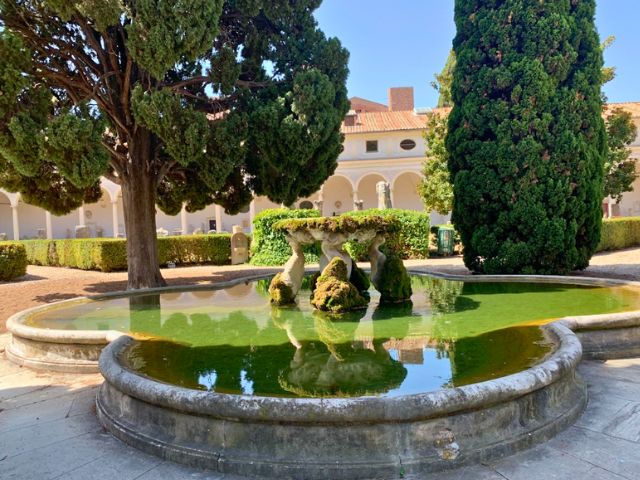- Sign up & get a FREE ebook Subscribe NOW!
- Romewise Home Page
- Museums in Rome
- national roman museum
The National Roman Museum locations - Must-See Sites in Rome!
Is the Rome National Museum (Museo Nazionale Romano) on your list of places to visit on your next trip?
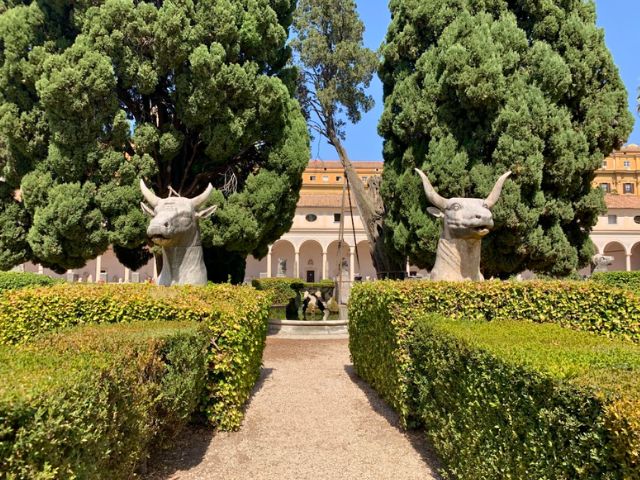 The cloister garden in the Baths of Diocletian complex is just one part of the National Roman Museums collection, keep reading for details of all the others!
The cloister garden in the Baths of Diocletian complex is just one part of the National Roman Museums collection, keep reading for details of all the others!Join me as I uncover everything you need to know about this impressive collection of artifacts and history displayed in four incredible buildings across the Eternal City.
Everything you need to know about the four locations of the Museo Nazionale Romano
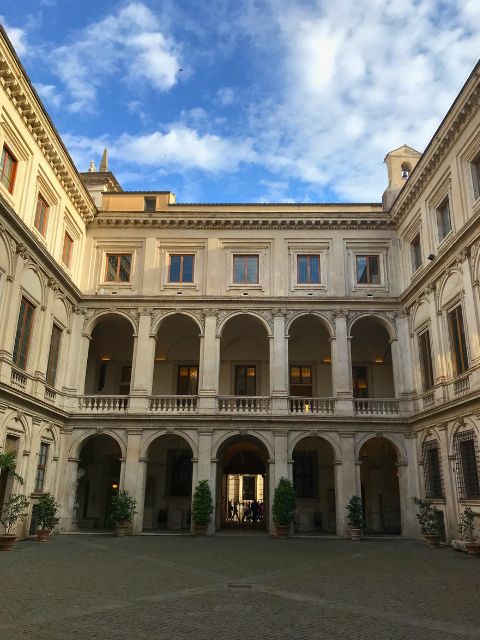 The courtyard of Palazzo Altemps sets the scene for your visit to this branch of the National Roman Museum
The courtyard of Palazzo Altemps sets the scene for your visit to this branch of the National Roman MuseumIf you’re planning to visit one of the amazing museums during your trip, you might want a glimpse of what you should expect.
Not only will I cover why the Museo Nazionale Romano collection is split out, but I’ll offer a detailed overview of each building (and what you should see!).
Now let’s dive in.
On this page we'll be exploring the different branches of the National Roman museum:
- Why are there different locations?
- Palazzo Massimo
- Palazzo Altemps
- Baths of Diocletian
- Crypta Balbi
- How to visit all the National Roman Museum branches
The history of the National Roman museum
The Museo Nazionale Romano was founded in 1889 and was intended to be a 'Museum of Antiquities in the Capital of the Kingdom', with the new Italian state only coming into existence in 1870.
Rome's urban landscape expanded hugely at the dawn of industrialization, with grand new buildings and roads being built with the wealth of the new state.
The builders kept discovering artistic, historical, and cultural works of exceptional value, and it was immediately recognized that these needed to be preserved and studied.
The museum originally housed a collection of works from the Kircherian museum, but this collection was continually expanding with these new finds.
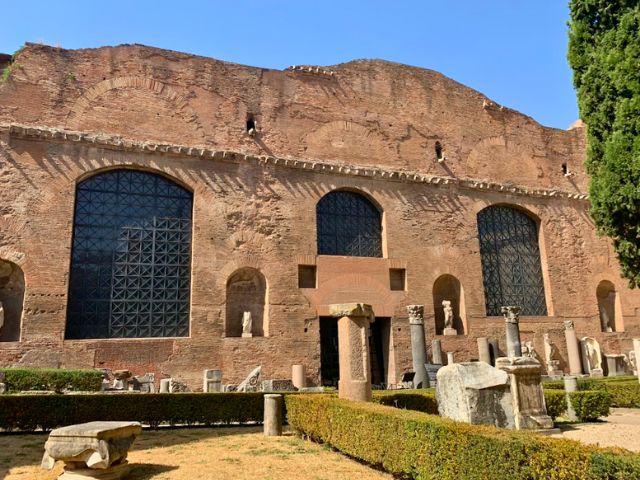 The Baths of Diocletian were the original home of the different items that were the basis of the collection
The Baths of Diocletian were the original home of the different items that were the basis of the collectionThe original museum was created in the charterhouse area of the Baths of Diocletian, which remained the home of the collection until the 1980's.
The National Roman museum acquired the Palazzo Massimo alle Terme, Palazzo Altemps and Crypta Balbi buildings at this time, moving out sections of the collections to the different buildings to create more coherent exhibits.
Moving out parts of the collection allowed renovations to be done to the Baths of Diocletian complex, expanding the visit area.
After years of significant renovations to Palazzo Massimo and Altemps they opened in 1998 and 1997 respectively.
Crypta Balbi was last to open in 2001, after a major excavation and restoration of the ancient Roman buildings found within the city block allowed them to display the day-to-day lives of citizens in ancient Rome.
The individual National Roman museum collections
Palazzo Massimo alle Terme
Palazzo Massimo is home to a large selection of frescoes, sculptures, busts and stunning mosaics from ancient Rome.
The purpose of this location is to showcase the stunning artistic creations.
Four floors of display make this one of the must-visit museums in Rome.
Palazzo Altemps
This is a beautiful 15th century palace that displays a large collection of ancient Greek and Roman art and antiquities.
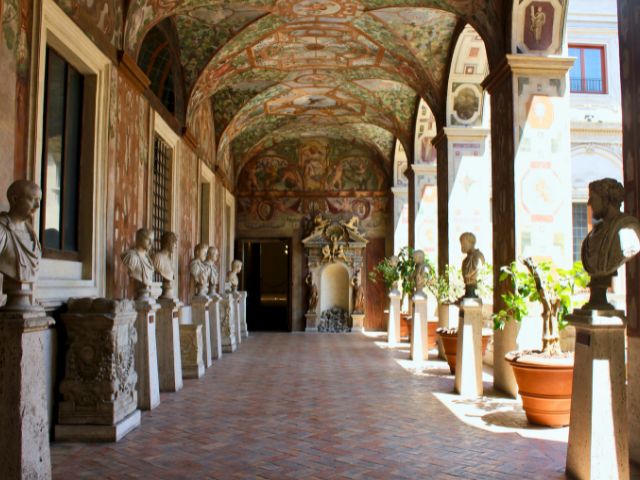 I love the quiet halls of Palazzo Altemps, it's the perfect place to get away from the busy streets of Rome
I love the quiet halls of Palazzo Altemps, it's the perfect place to get away from the busy streets of RomeBoth the palace and the displays are worth visiting, plus it's never busy so is a great place to escape the crowds at busy times of year.
Terme di Diocleziano
The ancient Roman Baths of Diocletian were built back in 305 CE and the complex is absolutely huge.
You can explore the meticulously preserved baths and over 400 works of ancient art around the cloister garden.
Crypta Balbi
This unique museum displays archaeological objects from ancient Rome.
It largely depicts how the Roman people lived day-to-day between the 5th and 10th centuries.
You’ll also see the original ruins of a Roman theater, bathhouses, and homes.
National Roman Museum - Palazzo Massimo alle Terme
Palazzo Massimo alle Terme is a wonderland for history and art buffs, boasting four floors of treasures from the Roman world.
From sculptures and frescoes to sarcophagi and ancient artwork, you can easily spend an entire day working through one of the best archaeological collections anywhere in Rome.
What to see at Palazzo Massimo
Ground Floor
The start of the collection on the ground floor uses busts and statues arranged chronologically to give you an insight into the origins of ancient Rome.
It starts with the Republican era, through Julius Caesar to the first emperor Augustus and his family.
This floor is also home to ancient Greek sculptures that captivated the Romans, who made numerous copies of the most famous pieces of art.
These lovingly-made copies are sometimes the only examples we still have today as the originals were lost.
Part of this Greek collection is the unmissable 'Boxer at Rest' or 'Seated Boxer'.
It’s one of the best examples of bronze artwork from the Hellenistic period and portrays a more realistic and less heroic ideal than we see in earlier sculptures, which captured the Roman imagination.
Don't miss the information boards on the wall telling the story of the ancient sculpture's discovery.
First Floor
Once you've explored the ground floor, head upstairs.
This floor continues the story of ancient Rome's rulers, with busts of the Flavian dynasty (who built the Colosseum), emperors Trajan, Hadrian, Caracalla and more.
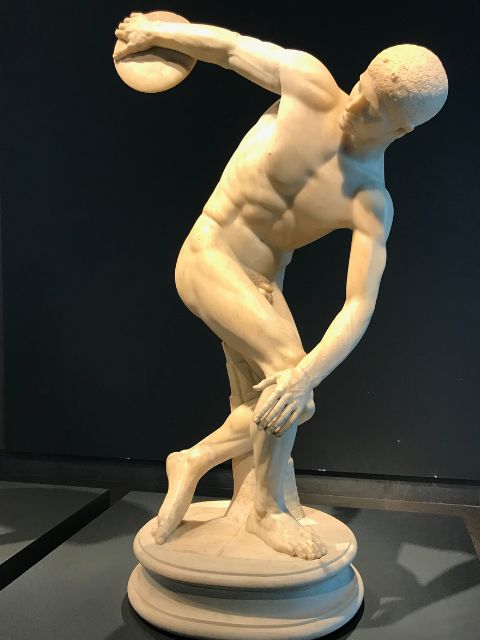 It's no wonder this Discus Thrower sculpture was popular with the ancient Romans - we know this because multiple ancient copies have been found!
It's no wonder this Discus Thrower sculpture was popular with the ancient Romans - we know this because multiple ancient copies have been found!There are also more sculptures from ancient Rome, of which the most famous is the 'Discus Thrower', a wonderful copy of a Greek original.
You can also see the remains of a pleasure ship built by emperor Caligula found in Lake Nemi.
Second Floor
The frescoes on the upper floor are absolute must-sees while you’re in the museum.
The painted garden room of the Villa di Livia is a major highlight.
These frescoes were found in remarkably good condition when the villa was being excavated in the 19th century, and the display has been set up to mimic the original shape of the rooms.
The best preserved Roman frescoes from Villa Farnesina and Villa di Termini are also surprisingly vivid and worth taking the time to admire as you stroll around.
If you’re a fan of traditional Roman art, you’ll want to check out the mosaic section also on this same floor.
These traditional pieces date from the Republican era through to the Imperial period.
Keep an eye out for the mosaics with a bust of Dionysus as a boy and the one depicting the river Nile.
The basement houses a number of exhibits, including a coin collection, jewelry and other items from daily life in ancient Rome.
The basement area has been closed for some time however as they are renovating this whole area, and we do not yet have a confirmed date for when it will reopen.
Palazzo Massimo alle Terme practical visit information
Opening hours: Tuesday to Sunday from 9:30AM to 7PM (closed Mondays).
Last admission to the museum is at 6PM.
How to get there: Palazzo Massimo is just opposite the Rome Termini station central transport hub, so you can take the metro (line A or B) or any of the many buses that stop here.
You then just need to cross the road!
National Roman Museum - Palazzo Altemps
Palazzo Altemps is probably the grandest of the buildings associated with the Roman National Museum, and once belonged to Roman nobility.
This aristocratic museum houses Roman sculptures, Renaissance artwork, and beautiful frescoes that you can reach via labyrinthine stairways and winding corridors.
What to see at Palazzo Altemps
Palazzo Altemps is only a few steps away from Piazza Navona and the Pantheon, making it a prime pit-stop on a day of sightseeing.
It’s smaller than the main Palazzo Massimo and covers just 2 floors, filled with items from collections put together by several of Rome's famous families.
You’ll want to spend a bit of time walking around the elegant palace itself.
Not only does it boast beautiful Baroque fountains, but the frescoes and other architectural details are truly a sight to behold.
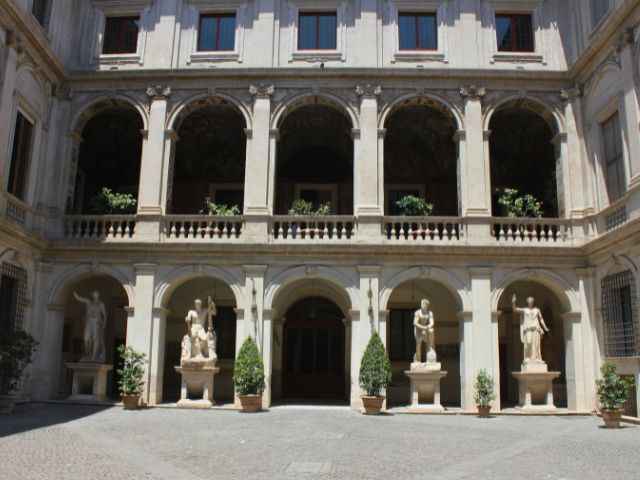 The collection at Palazzo Altemps is spread out across the whole building, including the large courtyard
The collection at Palazzo Altemps is spread out across the whole building, including the large courtyardOh, and don’t miss the ground floor courtyard which is decorated with pristine Roman statues.
And the frescoed loggia with its large arches and chromatic décor? Sensational!
Once you’ve done some exploring, be sure to check out the Boncompagni Ludovisi Collection.
The Ludovisi Throne is a must-see, but all the statues are worth a look if you're an art fan.
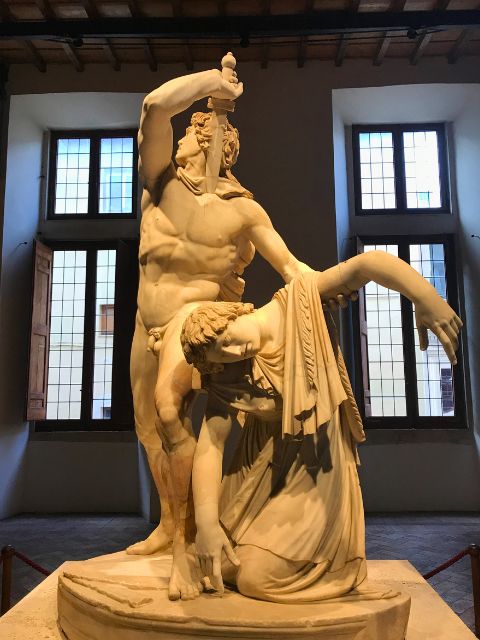 The sculpture known as the 'Galatian Suicide' is one of the many incredible pieces in the Ludovisi collection
The sculpture known as the 'Galatian Suicide' is one of the many incredible pieces in the Ludovisi collectionTake your time weaving through the different rooms and enjoy the juxtaposition between the pieces of art from antiquity displayed in the 15th century palace.
Palazzo Altemps practical visit information
Opening hours: Tuesday to Sunday from 9:30AM to 7PM (last admission at 6PM).
The museum is closed on Mondays.
How to get there: Located across the road from the north end of Piazza Navona, there are a number of buses that stop nearby, as well as a taxi rank.
From the Pantheon you can get to the museum building on foot in about 8 minutes by walking along Via dei Pianellari.
No matter what season you visit Rome, here are 4 essential things we recommend never leaving home without:
National Roman Museum - Baths of Diocletian
As you might have guessed from the name, the Baths of Diocletian is an ancient bath complex.
There’s an incredible range of ancient Roman artifacts to see here (and that’s without taking the bath structures themselves into account!).
What to see at the Baths of Diocletian
The main thing you need to do while you’re here is to check out the ancient baths.
They were built back in the 3rd century CE by the order of ancient Roman emperor Maximian, but named for his co-emperor Diocletian.
By the 1500's the site was not in good condition, and in 1561 Pope Pius IV ordered a new church and charterhouse to house an order of monks to be built on the site.
None other than Michelangelo (now 86 years old) was asked to design the new complex, and he used elements of the ancient Roman structure when doing so.
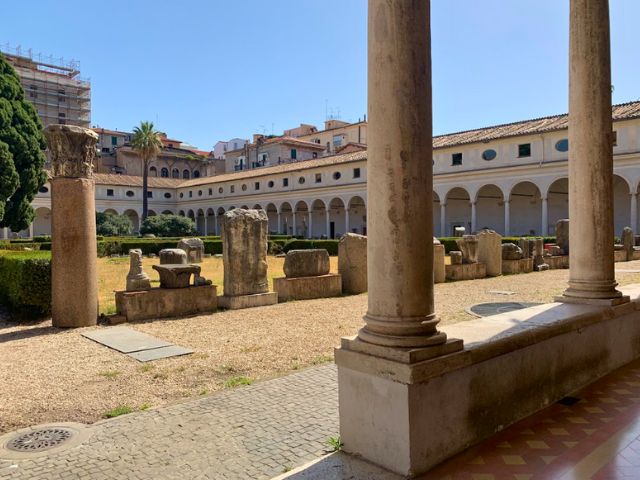 The church and monastic complex incorporated elements of the ancient ruins, so today you can visit both
The church and monastic complex incorporated elements of the ancient ruins, so today you can visit bothAn order of Carthusian monks lived in the complex until 1884, at which point the Italian state took over and created the original Museo Nazionale Romano collection.
The site preserves as much of the ancient and Renaissance buildings as possible, giving a unique insight into how Rome is a city continually changing.
Walking through the different elements will feel like stepping back in time!
Once you’ve marvelled at the baths, head out to the cloister garden where you’ll see various pieces of ancient relics on display among the gardens, trees and fountains.
There’s a large focus on statues, but you’ll also spot several reliefs and sarcophagi dotted around the cloister of Michelangelo.
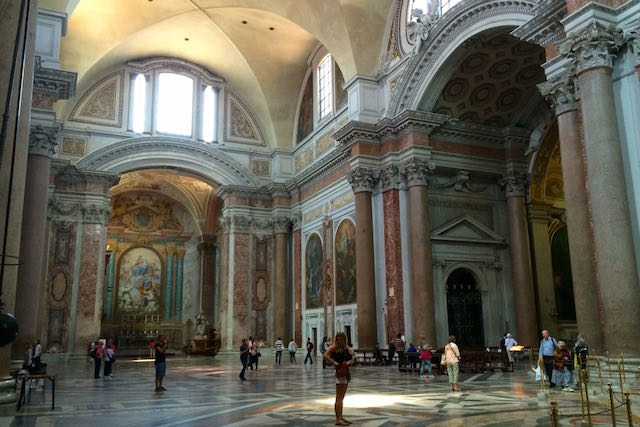 The church is laid out differently to others in Rome because it was built on the outline of the ancient central hall
The church is laid out differently to others in Rome because it was built on the outline of the ancient central hallAfter visiting, walk around the corner and go inside the church of Santa Maria degli Angeli e dei Martiri to get a complete picture of the ancient complex.
The church was built on the outline of the bath's central hall, giving you a sense of how huge the bath complex was!
Practical visit information
Opening hours: Tuesday to Sunday from 9:30AM to 7PM (last admission at 6PM).
How to get there: This part of the museum is steps away from Rome’s Termini station and Piazza della Reppublica, so you can either take the metro or one of the many buses that stop nearby.
The perfect 3-day itinerary in Rome
Trying to figure out how to organize your visit to Rome? I've got the perfect 3-day itinerary for first-time visitors (or those who have not been here in a while.) It works for a 2.5 day visit as well.
In my 3-day itinerary, you'll see all the major must-see Rome attractions like the Vatican, Colosseum, Trevi Fountain, Pantheon, Piazza Navona, Spanish Steps, and much more.
And if you have more time, or want suggestions for extra/other things to do, you'll find that there too.
Visit my page with the best 3-day itinerary in Rome for first-timers.
National Roman Museum - Crypta Balbi
The Crypta Balbi opened in 2001 and houses the archaeological finds of an extensive 1981 dig by Daniel Manacorda.
What to see in the Crypta Balbi
This part of ancient Rome was home to theaters, houses, shops and more.
This branch of the museum aims to make people aware of what the ancient city looked like away from the grand Colosseum or Circus Maximus, along with how it evolved over the centuries.
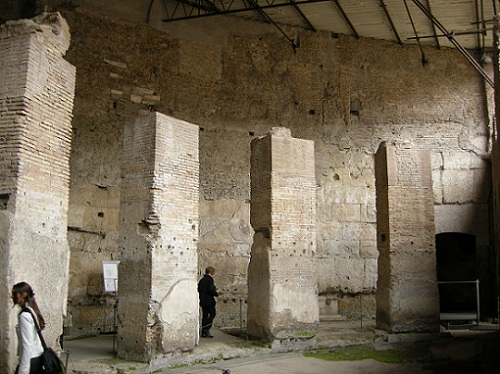 The different parts of the Crypta Balbi showcase the ancient Roman streets they found here while excavating
The different parts of the Crypta Balbi showcase the ancient Roman streets they found here while excavatingThe ground floor delves into the history of the buildings on this block.
The first floor takes you on a journey through Rome in the Middle Ages and largely focuses on the city between the 5th and 10th centuries CE.
From ceramic pottery to daily tools and a collection of Byzantine coins, it’s a dream for history buffs.
If you want to head to the basement, you’ll get to see the remains of the Theatre of Balbus (totally worth checking out!).
As of the time of writing, the Crypta Balbi branch of the Roman National Museum is closed for a huge renovation and improvement project and we do not have a fixed date for when it will be reopening yet.
Practical visit information
Opening hours: Closed for renovations as of January 2023 and remains closed as of May 2025.
How to get there: Crypta Balbi is just a few minutes walk from the Jewish Ghetto which is tucked between the Tiber and Piazza Venezia and close to Largo Argentina.
You can either walk here from nearby attractions, or take one of the many trams or buses that stop nearby.
Ready to plan your trip?
Book your train
Planning to travel between cities in Italy and other parts of Europe?
Use Trainline to see all the different options available across the different rail companies.
Find your hotel
Find your perfect place to stay in Rome.
Use Booking.com to choose between hotels, guesthouses, and self-catering apartments in neighborhoods throughout the Eternal City.
Buy your TurboPass
Purchase the convenient Turbopass and visit all of Rome's top attractions including the Colosseum, Pantheon, and Vatican.
With one handy pass, it's all included.
How to visit the Roman National Museum branches
Visiting the important national collection of the Museo Nazionale Romano should be high on your list, especially if you're interested in history and art.
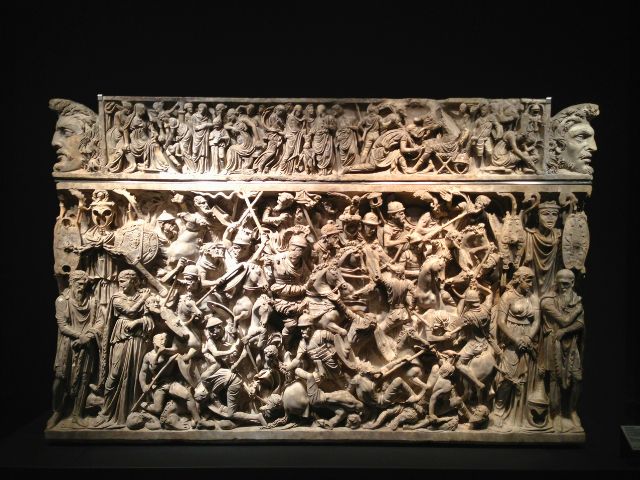 There are so many things to see at the different branches of the National Roman Museum, this intricate ancient sarcophagus in Palazzo Massimo is particularly impressive!
There are so many things to see at the different branches of the National Roman Museum, this intricate ancient sarcophagus in Palazzo Massimo is particularly impressive!Ticket Information
New Unified Ticket for the National Roman Museum
Starting May 20th 2025, visitors will need just one ticket to access all four sites of the National Roman Museum.
The new unified ticket, priced at €15.00, grants single entry to each museum location and is valid for 7 days from the date of the first visit.
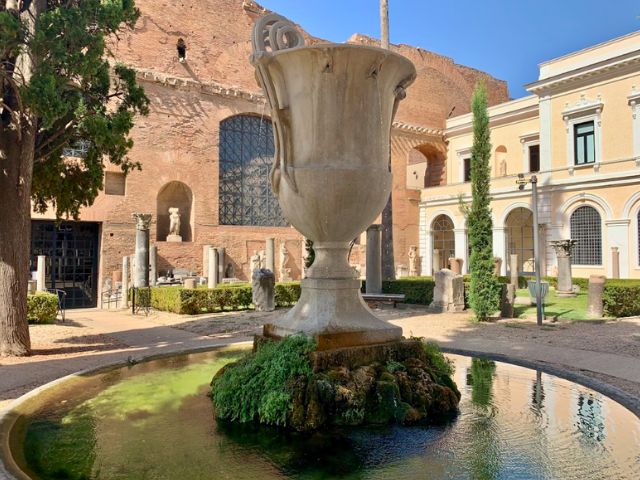 You can visit the Baths of Diocletian one day, and then the other sites at any time in the next 7 days if you go for the combo ticket
You can visit the Baths of Diocletian one day, and then the other sites at any time in the next 7 days if you go for the combo ticketThe museums are part of the Free Sunday event, and also offer reduced price entrance for some people (kids get in for free).
Take a look at all the details on their website.
Booking in Advance
While it is never a bad idea to book ahead, especially if you're visiting Rome during one of the busier times of year, these museums are rarely busy enough for this to be necessary.
However, it does save you time if you've booked in advance as then you can head straight in with your ticket, ready to show the attendant at the entrance.
Visiting
At a minimum you should visit Palazzo Massimo, which is the most interesting collection and has some must-see sights.
If you want to visit the other branches as well, given the ticket allows you a week, I'd recommend combining seeing these museums with other sights.
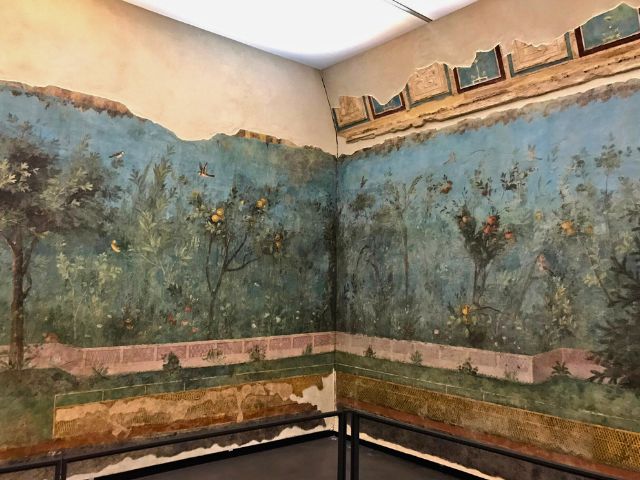 The frescoes of the Villa Livia in Palazzo Massimo should be top of your list, but there is a lot to see in all the different branches
The frescoes of the Villa Livia in Palazzo Massimo should be top of your list, but there is a lot to see in all the different branchesSpreading out your visits allows you to see the collection in the wider context of the Eternal City.
Here are some of my suggested visit combinations:
- Visit Palazzo Massimo in the afternoon, after visiting the Roman Forum and Palatine Hill in the morning. Especially good during the summer, when it's hotter in the afternoon and you want to be out of the sun!
- Visit the Baths of Diocletian, followed by the Baths of Caracalla to get a better idea of what the ancient complex would have been like.
- Visit Palazzo Altemps either before or after the Galleria Borghese and see how Rome's nobility collected ancient art and sculpture to reinforce their own legacy.
If you have limited time however, you could easily visit all the branches in one day.
Romewise's Top Travel Resources
Ready to book your trip to Rome? Take a look at these helpful links to companies we use and trust:
- Keep your travel spending simple with the Wise card, which removes all the worry about exchange rates and high transaction fees all over the world
- Search for and book your perfect accommodation
- Our complete guide to what to pack for Rome
- The number one travel accessory, a multi-point travel adapter and voltage converter
- Browse a huge range of tours in Rome and beyond
- Experience unique tours and special access to Rome's most popular sights
- Protect yourself with comprehensive travel insurance
Within this post there are some affiliate links for products and services. For more details about our affiliate policy click here.
Get your 100% free Rome trip planner now!
Simply sign-up today for our free newsletter and get the Romewise Quick Start guide to Rome:
We are committed to respecting your data. Click for our Privacy Policy.
Comments? Questions? Suggestions?
Please come over to the private Romewise Facebook group and join in the conversation.
You will often find me there, happy to answer your questions / comments!
You will also meet other Rome lovers and experts, too.
What are you waiting for?
- Romewise Home Page
- Museums in Rome
- national roman museum

